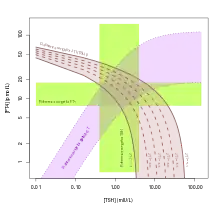TSH-Index
Mit Hilfe des von Andreas Jostel eingeführten TSH-Index (TSHI), der auch nach ihm als Jostel-Index bezeichnet wird, kann die thyreotrope Funktion des Hypophysenvorderlappens quantitativ abgeschätzt werden.[1][2][3] Die Gleichung ist vom logarithmischen Standardmodell der Schilddrüsenhomöostase abgeleitet.[4][5][6][7]
Berechnung

Er wird mit
aus den Spiegeln für TSH, FT4 und einem Korrekturkoeffizienten für das logarithmische Standardmodell (β = 0,1345) berechnet.
Darüber hinaus wurde ein standardisierter TSH-Index definiert, der mit[1]
berechnet wird. Im Sinne einer z-Transformation berücksichtigt er Mittelwert (2,7) und Standardabweichung (0,676) des TSHI.[6]
Referenzbereiche:
| Parameter | Untergrenze | Obergrenze | Maßeinheit |
| TSHI | 1,3[1] | 4,1[1] | |
| sTSHI | -2[1] | 2[1] | |
Klinische Bedeutung
Der TSH-Index ist bei Patienten mit thyreotroper Insuffizienz reduziert.[1] Eine Reduktion des standardisierten TSH-Index wurde auch in Fällen eines Non-Thyroidal-Illness-Syndroms beobachtet.[8]
Siehe auch
Einzelnachweise
- A. Jostel, W. D. Ryder, S. M. Shalet: The use of thyroid function tests in the diagnosis of hypopituitarism: definition und evaluation of the TSH Index. In: Clin. Endocrinol. (Oxf). Band 71, Nr. 4, Oktober 2009, S. 529–534, doi:10.1111/j.1365-2265.2009.03534.x, PMID 19226261.
- L. Persani, G. Brabant, M. Dattani, M. Bonomi, U. Feldt-Rasmussen, E. Fliers, A. Gruters, D. Maiter, N. Schoenmakers, A. S. P van Trotsenburg: 2018 European Thyroid Association (ETA) Guidelines on the Diagnosis and Management of Central Hypothyroidism. In: European Thyroid Journal. Band 7, Nr. 5, Oktober 2018, S. 225–237, doi:10.1159/000491388, PMID 30374425.
- L. Persani, B. Cangiano, M. Bonomi: The diagnosis and management of central hypothyroidism in 2018. In: Endocrine connections. 1. Januar 2019, doi:10.1530/EC-18-0515, PMID 30645189.
- S. Reichlin, R. D. Utiger: Regulation of the pituitary-thyroid axis in man: relationship of TSH concentration to concentration of free and total thyroxine in plasma. In: J Clin Endocrinol Metab. Band 27, Nr. 2, Februar 1967, S. 251–255, doi:10.1210/jcem-27-2-251, PMID 4163614.
- J. L. Cohen: Thyroid-stimulation hormone and its disorders. In: K. L. Becker (Hrsg.) Principles and Practice of Endocrinology and Metabolism. J. B. Lippincott Company, Philadelphia, PA, USA, 1990, S. 144–152.
- Johannes W. Dietrich, Gabi Landgrafe, Elisavet H. Fotiadou: TSH and Thyrotropic Agonists: Key Actors in Thyroid Homeostasis. In: Journal of Thyroid Research. 2012, S. 1–29, doi:10.1155/2012/351864. PMID 23365787.
- Johannes W. Dietrich, Gabi Landgrafe-Mende, Evelin Wiora, Apostolos Chatzitomaris, Harald H. Klein, John E. M. Midgley, Rudolf Hoermann: Calculated Parameters of Thyroid Homeostasis: Emerging Tools for Differential Diagnosis and Clinical Research. In: Frontiers in Endocrinology. Band 7, 9. Juni 2016, doi:10.3389/fendo.2016.00057, PMID 27375554, PMC 4899439 (freier Volltext).
- S. Fan, X. Ni, J. Wang, Y. Zhang, S. Tao, M. Chen, Y. Li, J. Li: Low Triiodothyronine Syndrome in Patients With Radiation Enteritis: Risk Factors and Clinical Outcomes an Observational Study. In: Medicine. Band 95, Nr. 6, Februar 2016, S. e2640, doi:10.1097/MD.0000000000002640, PMID 26871787.